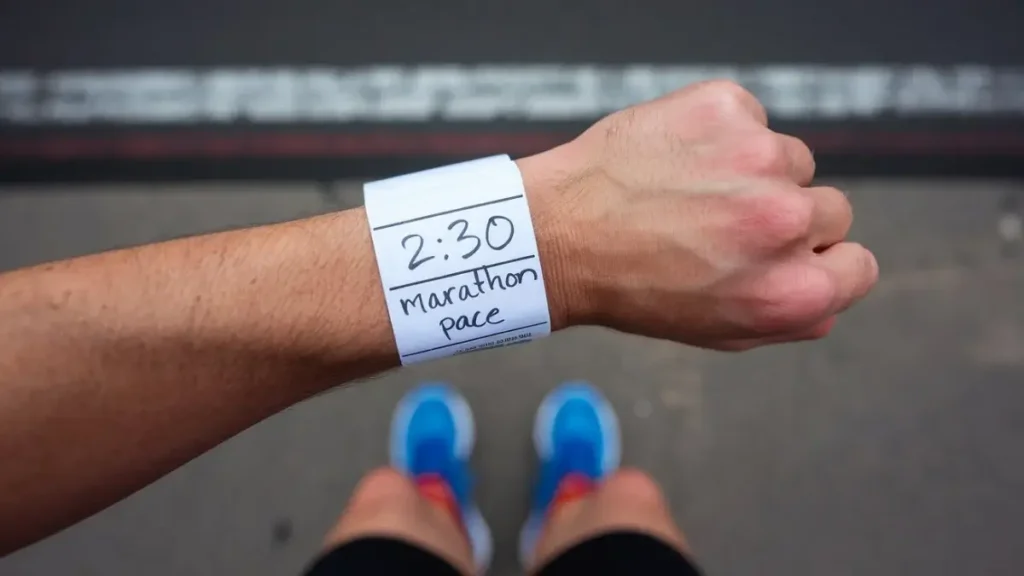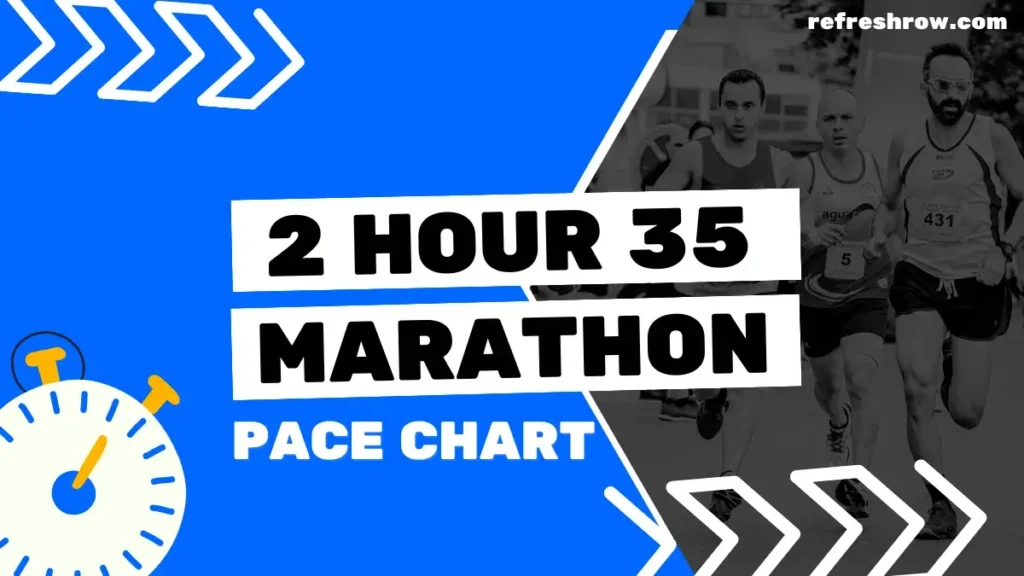To run a 3:35 hour marathon you need to run at a pace of 8:12 per mile or 5:06 per kilometer.
Following the splits below (and shaving off a second), you’ll run a sub 3:35 marathon.
I’d recommend aiming to run 1-2 minutes ahead of the split target time from 10 miles, as you’ll likely come up against crowding on race day.
3:35 Marathon Pace in Miles
| Mile | Split |
|---|---|
| 1 | 8:12 |
| 2 | 16:24 |
| 3 | 24:36 |
| 4 | 32:48 |
| 5 | 41:00 |
| 6 | 49:12 |
| 7 | 57:24 |
| 8 | 1:05:36 |
| 9 | 1:13:48 |
| 10 | 1:22:00 |
| 11 | 1:30:12 |
| 12 | 1:38:24 |
| 13 | 1:46:36 |
| 14 | 1:54:48 |
| 15 | 2:03:00 |
| 16 | 2:11:12 |
| 17 | 2:19:24 |
| 18 | 2:27:36 |
| 19 | 2:35:48 |
| 20 | 2:44:00 |
| 21 | 2:52:12 |
| 22 | 3:00:24 |
| 23 | 3:08:36 |
| 24 | 3:16:48 |
| 25 | 3:25:00 |
| 26 | 3:33:12 |
| 26.2 | 3:35:00 |
Download
3:35 Marathon Pace in KM
| KM | Split |
|---|---|
| 1 | 5:06 |
| 2 | 10:11 |
| 3 | 15:17 |
| 4 | 20:23 |
| 5 | 25:29 |
| 6 | 30:34 |
| 7 | 35:40 |
| 8 | 40:46 |
| 9 | 45:52 |
| 10 | 50:57 |
| 11 | 56:03 |
| 12 | 1:01:09 |
| 13 | 1:06:14 |
| 14 | 1:11:20 |
| 15 | 1:16:26 |
| 16 | 1:21:32 |
| 17 | 1:26:37 |
| 18 | 1:31:43 |
| 19 | 1:36:49 |
| 20 | 1:41:54 |
| 21 | 1:47:00 |
| 22 | 1:52:06 |
| 23 | 1:57:12 |
| 24 | 2:02:17 |
| 25 | 2:07:23 |
| 26 | 2:12:29 |
| 27 | 2:17:35 |
| 28 | 2:22:40 |
| 29 | 2:27:46 |
| 30 | 2:32:52 |
| 31 | 2:37:57 |
| 32 | 2:43:03 |
| 33 | 2:48:09 |
| 34 | 2:53:15 |
| 35 | 2:58:20 |
| 36 | 3:03:26 |
| 37 | 3:08:32 |
| 38 | 3:13:37 |
| 39 | 3:18:43 |
| 40 | 3:23:49 |
| 41 | 3:28:55 |
| 42 | 3:34:00 |
| 42.2 | 3:35:00 |
Download
Other Marathon Pace Charts
Targeting a different time?
Check out the Full Marathon Pace Chart in Miles or KM
Or select a specific finishing time below:
| 3:00 | 4:00 | 5:00 | |
| 3:05 | 4:05 | 5:15 | |
| 3:10 | 4:10 | 5:30 | |
| 3:15 | 4:15 | 5:45 | |
| 3:20 | 4:20 | 6:00 | |
| 3:25 | 4:25 | 6:15 | |
| 2:30 | 3:30 | 4:30 | 6:30 |
| 2:35 | 3:35 | 4:35 | 6:45 |
| 2:40 | 3:40 | 4:40 | 7:00 |
| 2:45 | 3:45 | 4:45 | |
| 2:50 | 3:50 | 4:50 | |
| 2:55 | 3:55 | 4:55 |
Training for a 3:35 Marathon
Is 3:35 a Good Marathon Time?
Well, what do the stats say?
Run Repeat conducted a study that contains 19,614,975 marathon results from more than 32,335 races across the globe, here is how a 3:35 marathon compares against age and gender for the races recorded:
| Overall | You’re faster than 88.6% of all runners. |
| Male | You’re faster than 83.4% of males. |
| Female | You’re faster than 95.5% of females. |
| <20 | You’re faster than 86.5% of under 20s. |
| 20-29 | You’re faster than 86.5% of 20-29 year olds. |
| 30-39 | You’re faster than 87.4% of 30-39 year olds. |
| 40-49 | You’re faster than 88.6% of 40-49 year olds. |
| 50-59 | You’re faster than 96.1% of 50-59 year olds. |
| >60 | You’re faster than 98.4% of over 60s. |
Training Runs and Paces for a 3:35 Marathon
To break a 3:35 marathon you’ll need to do some serious distance in your training, I recommend at least 35 miles (56km) per week.
You’re also going to need to make sure you’ve crossed off these milestones for other race distances:
- A 5k in 22:20 mins
- A 10k in 46:40 mins
- A half marathon in 1 hour 37 mins
Training Paces
| Pace | Mins per Mile | Mins per KM |
|---|---|---|
| Easy | 9:14 | 5:44 |
| Steady | 8:12 | 5:05 |
| 10k | 7:31 | 4:40 |
| 5k | 7:12 | 4:29 |
| 1 Mile | 6:42 | 4:11 |
Weekly Mileage Targets
| Target Mileage: | Gradually increase your weekly mileage from 40 miles (64 km) to a peak of 68 miles (109 km). |
| Incremental Increase: | Increase mileage by approximately 10% each week, with every fourth week as a recovery week where mileage is reduced by 20-30%. Make sure to taper for the last 1-2 weeks. |
Long Run Structure
| Total Distance: | Build up to long runs of 20-22 miles (32-35 km). |
| Segment Example: | First 5 miles (8 km): Easy pace, heart rate 140-150 bpm (approximately 9:30/mile or 5:54/km). Next 1 mile (1.6 km): Fast pace at 7:00/mile (4:21/km). Next 5 miles (8 km): Medium effort, heart rate around 160 bpm (approximately 8:00/mile or 4:58/km). Repeat: Repeat the segment twice (5 miles easy, 1 mile fast, 5 miles medium), you can taper the final 2 miles if required. |
Why This Works: Incorporating varied paces within long runs enhances lactate tolerance, which helps on race day when you’ve got to maintain pace despite feeling fatigued. By practicing surges during a run, you can build up your physical and mental resilience (lots of elite marathon runners use these strategies during their training)
Alternating Long Runs: Alternate between structured long runs (easy/fast segments) and easier long runs. For easier long runs, maintain a steady, comfortable pace throughout, focusing on mileage rather than speed to aid recovery.
Speedwork Sessions
| Short Intervals: | – 800m repeats at 3:30 per interval (4:22/km). – Aim for 6-12 repetitions with equal time for recovery. |
| Mile Repeats: | – 1 mile repeats at 7:00 per mile (4:21/km). – Aim for 6-12 repetitions with a 1-2 minute recovery jog. |
| Longer Intervals: | – 2 mile repeats at 7:10 per mile (4:27/km). – Aim for 5-8 repetitions with a 2-3 minute recovery jog. |
Recovery and Rest Days
| Rest Days: | You don’t need to incorporate rest days if you are using recovery runs, but I recommend taking 1 (or a max of 2) per week to allow your body to recover and prevent overtraining. |
| Easy Run Days: | Include 1-2 easy run days per week at a relaxed pace of 9:45/mile (6:03/km), covering 5-10 miles (8-16 km) per day. Try to keep your heart rate below 140 bpm on easy days to ensure proper recovery and aerobic development. |
My Tips to Run a Sub 3:35 Marathon
Give Cross Training a go
I can not overstate enough how powerful the benefits of cross-training are.
Instead of running every day, I incorporated activities like cycling, swimming, and strength training into my routine, on my “off days”.
This helped me avoid the monotony of running.
I don’t if you’re like me, but sometimes when I’ve been running pretty much every day for months, and I’ve listened to every podcast under the sun, boredom can be a big hurdle to overcome to get me out the door.
Cross-training also strengthened different muscle groups, ultimately making me a stronger, more well-rounded athlete and reduced the risk of injury.
As these activities usually involve more equipment than running and a bit more organizing, I joined a weekly spin class, which provided a high-intensity cardio workout that complemented my running perfectly (and I love the pumping techno music).
Be Mentally Prepared
Running a marathon is as much a mental challenge as it is a physical one.
During my preparation for the 3:35 marathon, I started incorporating mental training techniques into my weekly routine.
Visualization exercises, where I imagined myself running strong and steady through different parts of the course, were incredibly helpful. I focused on the tricky 20-mile mark a lot, where I knew I’d have to overcome succumbing to “the wall”.
I also practiced mindfulness and meditation, which improved my focus and helped me stay calm under pressure.
Ultimately, when it came down to it on the day, I was able to push through the tough moments and maintain a positive mindset from start to finish.
Fit your Training Plan around your Life
One of the most impactful changes I made was customizing my training plan to fit my lifestyle and unique needs.
Instead of following a generic plan, I created a schedule that accommodated my work commitments, family time, and personal energy levels.
I included key workouts like tempo runs, intervals, and long runs, but I was flexible with the days and times I did them.
This personalized approach reduces stress and burnout, making training more sustainable and enjoyable.
By listening to my body and adjusting as needed, I was able to stay healthy and motivated.
However, this did mean I missed some sessions, and so it took longer to complete the full training plan.
I thought this might happen, so gave myself a few week’s buffer, so was able ti complete everything before the event (I’d suggest you do the same!).
Practice Running by Feel
Learning to run by feel rather than constantly checking my watch was a game-changer in my marathon training.
I started incorporating “effort-based” runs where I focused on maintaining a steady, comfortable effort instead of targeting specific paces.
This helped me become more in tune with my body and better manage my energy levels.
When I ran the marathon, this skill allowed me to adapt to the conditions and my own fluctuations in energy, leading to a more consistent and enjoyable race.
Trusting my instincts and running by feel ultimately helped me achieve my 3:35 marathon goal!


Row Brown is the founder of Refresh Row. He is a keen marathon runner, his favorite being the London Marathon. He’s now set himself the mission of Running the Entire Length of Spain, which is scheduled for late 2024.


